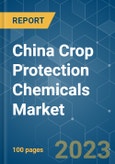Herbicides dominate the market
- China is a major producer of active ingredients that serve as the foundation for formulated agrochemicals and ready-made pesticides sold in many countries. The country is one of the world's largest producers and exporters of crop protection chemicals. Insecticides comprise an important segment in the crop protection chemicals market. The key drivers of the market are a high number of people, limited size of farms, rising food security, and an urgent need for efficient agricultural production. China occupied the highest share of 30.9% by value of the overall Asia-Pacific crop protection chemicals market in 2022.
- Herbicides accounted for the largest share of 39.9% by value in the Chinese crop protection chemicals market in 2022. In China, the use of herbicides has helped in weed control and, thus, increased yields by making it easier for farmers to grow more dwarf rice varieties that are less likely to compete with weeds. Even though there has been a large decline in traditional hand laborers who have moved out of rural areas to industrial zones, herbicides have allowed farmers to control weeds.
- In 2022, the insecticide segment held a significant share of 30.6% by value in the market. The most common pesticides registered for use in cotton are insecticides. Among them, phoxim has the highest number of registered active substances, including cypermethrin and beta-cypermethrin.
- With the increasing concern over the infestation of pests and diseases and the rise in international demand, companies and the government are continuously investing in research projects and developing new active ingredients to prevent crop damage from pests. The market is anticipated to register a CAGR of 5.4% during the forecast period.
China Crop Protection Chemicals Market Trends
IPM strategies and other pesticide reduction policies contributed to reduction in per hectare pesticides consumption
- Over the past few years, there has been a notable reduction in pesticide consumption per hectare in the country. During the historical period, there was a significant decline in pesticide usage to approximately 300 grams per hectare. In 2017, the consumption stood at 1,700 grams per hectare; however, by 2022, it had dropped to 1,400 grams per hectare.
- The considerable reduction in pesticide utilization per hectare can be largely attributed to the country's implementation of a stringent policy of zero growth in pesticide consumption.
- China has proactively promoted the adoption of Integrated Pest Management (IPM) strategies, encompassing a range of preventive measures, alternative techniques, and careful pesticide applications. As a result of this holistic approach, there has been a notable reduction in pesticide usage rates.
- China witnessed a significant decline in herbicide usage by 88.78 grams, primarily driven by the adoption of practices such as crop rotation by farmers. Crop rotation involves alternating different crops with varying growth patterns and nutritional requirements, effectively breaking the lifecycle of weeds. By implementing this practice, Chinese farmers have successfully disrupted weed growth cycles, resulting in reduced weed populations and a decreased reliance on herbicides.
- The other substantial decrease in pesticide usage per hectare was observed specifically in the category of insecticides, with a reduction of 58.31 grams from 2017 to 2022. This decline can be primarily attributed to government policies aimed at banning harmful insecticides and the adoption of transgenic crops.
- Other factors like setting limits on the maximum residue levels on the usage of pesticides reduced the per hectare consumption in the country.
The active ingredients' prices are majorly influenced by factors like weather conditions, pest outbreaks, energy prices, and labor costs in the country
- China is one of the major producers of active ingredients that form the base of formulated crop protection chemicals. Insecticides constitute the major share of pesticide production.
- Cypermethrin is the most widely used pyrethroid pesticide to control many pests, such as fruit flies, borers, and mealy bugs in vegetables and fruits in China. It was valued at USD 20.9 thousand per metric ton in 2022.
- Atrazine is a herbicide widely used to control various broadleaved weeds and grasses. China consumes more than 16,000 ton (97% technical) of atrazine annually. Atrazine is mainly used to control annual weeds in corn or sugarcane fields. China is one of the major suppliers of atrazine worldwide. It was priced at USD 13.7 thousand per metric ton in 2022.
- Mancozeb is a broad-spectrum contact fungicide used to control a number of fungal diseases, such as anthracnose, Pythium blight, leaf spot, downy mildew, Botrytis, rust, and scab in oilseed rape, lettuce, wheat, apples, tomatoes, table grapes, wine grapes, bulb onions, carrot, parsnip, shallot, and durum wheat. It was priced at USD 7.7 thousand per metric ton in 2022.
- Glyphosate is an organophosphorus broad-spectrum systemic herbicide and crop desiccant, priced at USD 1.1 thousand per metric ton in 2022. Glyphosate is mainly used to control weeds like grasses, sedges, and broadleaves. China is the largest producer and exporter of glyphosate in the world. In 2017, China exported over 300,000 ton of glyphosate technical, which met more than half of the global glyphosate demand.
- Factors like weather conditions, pest outbreaks, energy prices, and labor costs in the country majorly influence the prices of active ingredients.
China Crop Protection Chemicals Industry Overview
The China Crop Protection Chemicals Market is moderately consolidated, with the top five companies occupying 50.05%. The major players in this market are BASF SE, Bayer AG, FMC Corporation, Jiangsu Yangnong Chemical Co. Ltd and Syngenta Group (sorted alphabetically).Additional Benefits:
- The market estimate (ME) sheet in Excel format
- 3 months of analyst support
This product will be delivered within 2 business days.
Table of Contents
Companies Mentioned (Partial List)
A selection of companies mentioned in this report includes, but is not limited to:
- BASF SE
- Bayer AG
- Corteva Agriscience
- FMC Corporation
- Jiangsu Yangnong Chemical Co. Ltd
- Lianyungang Liben Crop Technology Co. Ltd
- Rainbow Agro
- Syngenta Group
- UPL Limited
- Wynca Group (Wynca Chemicals)
Methodology

LOADING...








